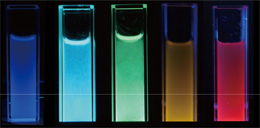Research Abstract
絡み合った多孔性フレームワークからの発光を用いた分子解読
本論文では、単一のホストドメインがある分子群を取り込み、それぞれの分子に対応する情報を読み出すことでそれらを区別する分子解読法について報告する。
Molecular decoding using luminescence from an entangled porous framework
2011年1月25日 Nature Communications 2 : 168 doi: 10.1038/ncomms1170

量子多体系に生じる準粒子は、現代物理学のさまざまな問題において重要な役割を担っている。半導体における励起子のボースアインシュタイン凝縮(BEC)は、多体電子中の光励起された準粒子において、予想されているが観測されていない量子統計現象の1つである。特に、亜酸化銅のパラ励起子は、輻射場との結合が切れているので、BECによって生じるコヒーレント集団が純粋に物質波的になるため、数十年来研究されてきた。しかし、2体非弾性衝突過程に起因して、超流動液体ヘリウム4温度ではBECの実現が困難なことがわかっている。したがって、励起子温度をさらに下げて、より低い臨界密度に調整する必要がある。今回我々は、励起子をサブケルビン温度に冷却し、空間的に閉じ込めることで、BECの臨界数を実現した。我々は、水素原子において議論されてきた緩和爆発として、BECが現れることを示す。この結果は、希薄な励起子が純粋にボソン的であり、BECが実際に生じていることを示している。
- JST戦略的創造研究推進事業ERATO型研究「北川統合細孔プロジェクト」
- 京都大学大学院工学研究科
- バスク大学(スペイン)
- 京都大学物質–細胞統合システム拠点(iCeMS)
- 株式会社リガクX線研究所
- 現所属:高輝度光科学研究センター/SPring-8
Chemosensors detect a single target molecule from among several molecules, but cannot differentiate targets from one another. In this study, we report a molecular decoding strategy in which a single host domain accommodates a class of molecules and distinguishes between them with a corresponding readout. We synthesized the decoding host by embedding naphthalenediimide into the scaffold of an entangled porous framework that exhibited structural dynamics due to the dislocation of two chemically non-interconnected frameworks. An intense turn-on emission was observed on incorporation of a class of aromatic compounds, and the resulting luminescent colour was dependent on the chemical substituent of the aromatic guest. This unprecedented chemoresponsive, multicolour luminescence originates from an enhanced naphthalenediimide.aromatic guest interaction because of the induced-fit structural transformation of the entangled framework. We demonstrate that the cooperative structural transition in mesoscopic crystal domains results in a nonlinear sensor response to the guest concentration.

